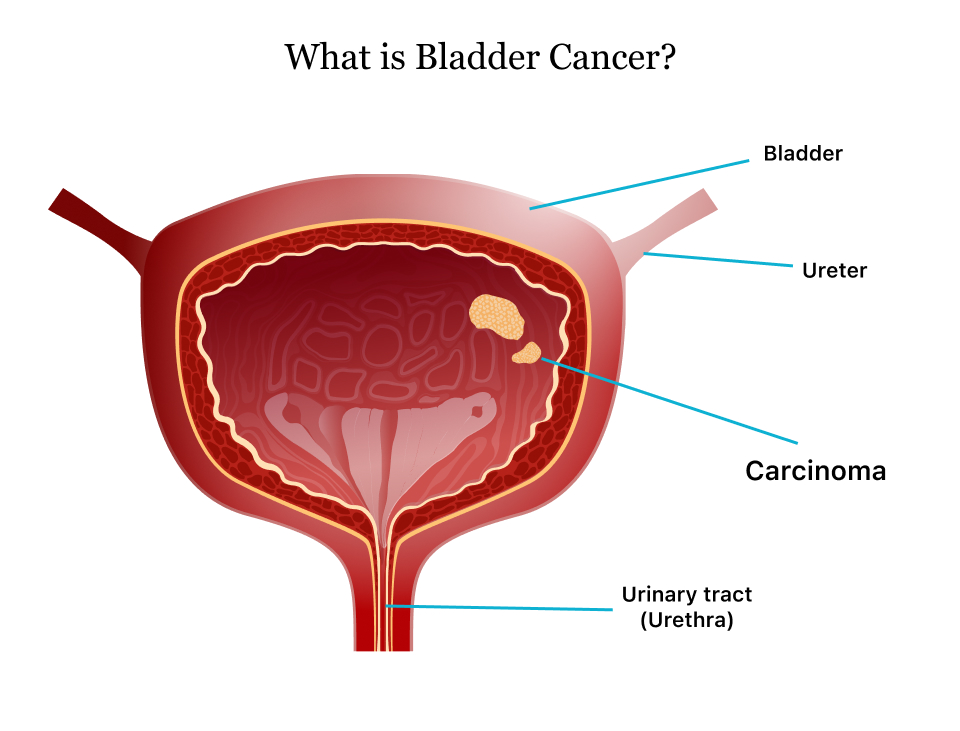Bladder Cancer
Bladder cancer is a type of cancer that begins in the cells of the bladder, the organ that stores urine. It is the most common cancer of the urinary system. Bladder cancer can occur at any age but is more common in older adults. The majority of bladder cancers are diagnosed at an early stage, and treatment options are available. Here are some key points about bladder cancer:

- Types of Bladder Cancer:
- Transitional cell carcinoma (TCC): This is the most common type of bladder cancer and originates in the urothelial cells lining the inside of the bladder.
- Squamous cell carcinoma: Arises from thin, flat cells that may form in response to long-term irritation and inflammation.
- Adenocarcinoma: A rare type of bladder cancer that starts in the glandular cells of the bladder lining.
- Risk Factors:
- Smoking: Cigarette smoking is a major risk factor and is linked to about half of all bladder cancer cases.
- Age: The risk of bladder cancer increases with age, and it is more common in older adults.
- Gender: Men are more likely than women to develop bladder cancer.
- Occupational exposures: Certain occupations involving exposure to certain chemicals, such as those in the dye, rubber, and leather industries, may increase the risk.
- Chronic bladder inflammation: Conditions that cause chronic irritation or inflammation of the bladder, such as recurrent urinary infections or bladder stones, may increase the risk.
- Signs and Symptoms:
- Blood in the urine (hematuria) is a common symptom and often the first sign of bladder cancer.
- Other symptoms may include urinary frequency, urgency, pain or discomfort during urination, and lower back pain.
- Diagnosis:
- Diagnosis involves a combination of medical history, physical examination, imaging studies (CT scans, MRIs), and laboratory tests.
- Cystoscopy: A procedure in which a thin tube with a camera is inserted into the bladder to visualize the inside and identify any abnormalities.
- Biopsy: Removal of a small tissue sample for examination under a microscope to confirm the presence of cancer.
- Staging:
- Staging helps determine the extent of the cancer and guides treatment decisions. Stages range from 0 (non-invasive) to IV (invasive and spread to other parts of the body).
- Treatment Options:
- Transurethral resection of bladder tumor (TURBT): A surgical procedure to remove cancerous tissue from the bladder lining.
- Intravesical therapy: Delivery of medications directly into the bladder to treat or prevent the recurrence of cancer.
- Partial or radical cystectomy: Surgical removal of part or the entire bladder, depending on the extent of the cancer.
- Chemotherapy: Using drugs to kill cancer cells or stop their growth.
- Immunotherapy: Stimulating the immune system to target and destroy cancer cells.
- Survival Rates:
- Prognosis varies based on factors such as the stage at diagnosis, the type of bladder cancer, and the overall health of the individual.
- Non-invasive bladder cancers have a favorable prognosis, while invasive cancers may have a more guarded outlook.
- Follow-Up and Monitoring:
- Individuals with a history of bladder cancer often require regular follow-up and monitoring to detect and address any recurrence.





